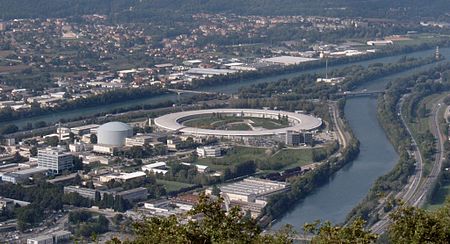European Synchrotron Radiation Facility
History of physicsInternational research institutesParticle acceleratorsResearch institutes in FranceScience and Technology Facilities Council ... and 3 more
Science and technology in EuropeScience and technology in GrenobleSynchrotron radiation facilities

The European Synchrotron Radiation Facility (ESRF) is a joint research facility situated in Grenoble, France, supported by 22 countries (13 member countries: France, Germany, Italy, the UK, Spain, Switzerland, Belgium, the Netherlands, Denmark, Finland, Norway, Sweden, Russia; and 9 associate countries: Austria, Portugal, Israel, Poland, the Czech Republic, Hungary, Slovakia, India and South Africa).Some 8,000 scientists visit this particle accelerator each year, conducting upwards of 2,000 experiments and producing around 1,800 scientific publications.
Excerpt from the Wikipedia article European Synchrotron Radiation Facility (License: CC BY-SA 3.0, Authors, Images).European Synchrotron Radiation Facility
Carrer de Sant Antoni Maria Claret, Barcelone
Geographical coordinates (GPS) Address Phone number Website Nearby Places Show on map
Geographical coordinates (GPS)
| Latitude | Longitude |
|---|---|
| N 45.208611111111 ° | E 5.69 ° |
Address
Sant Pau Recinte Modernista
Carrer de Sant Antoni Maria Claret 167
08025 Barcelone (Horta-Guinardó)
Catalogne, Espagne
Open on Google Maps








